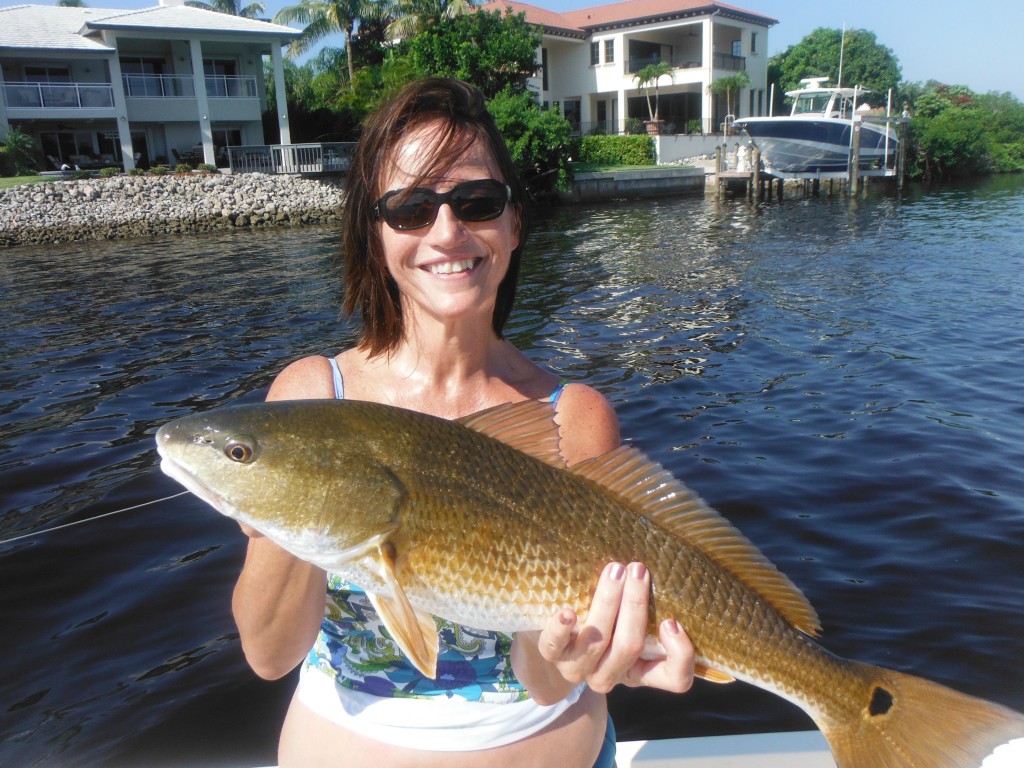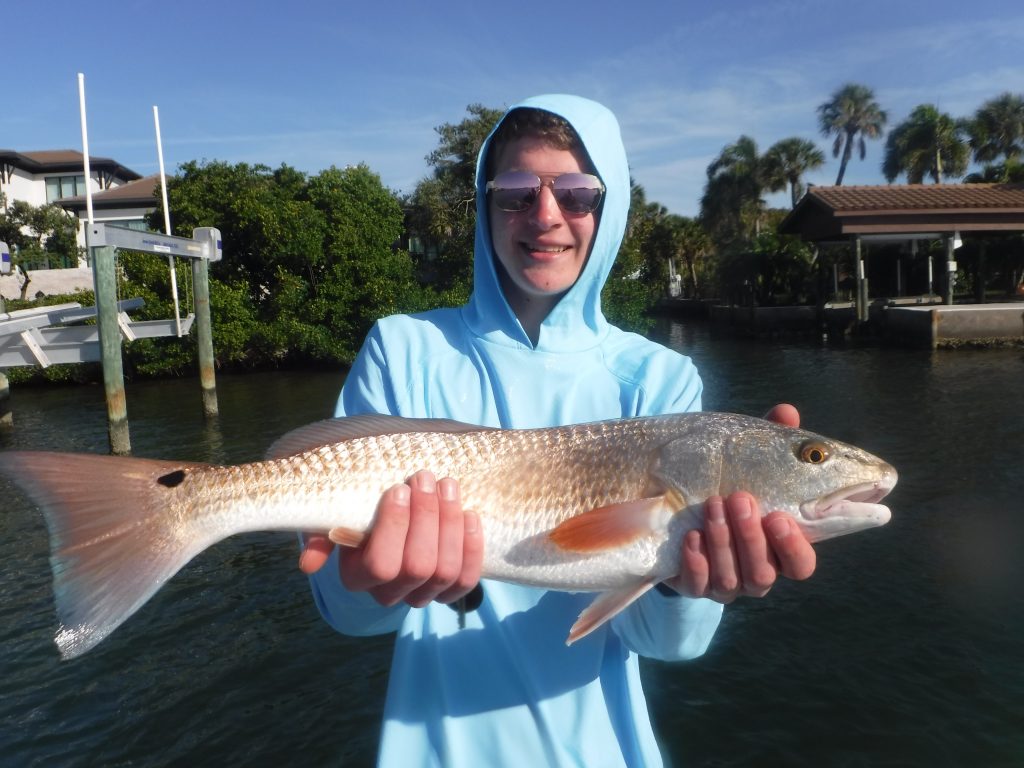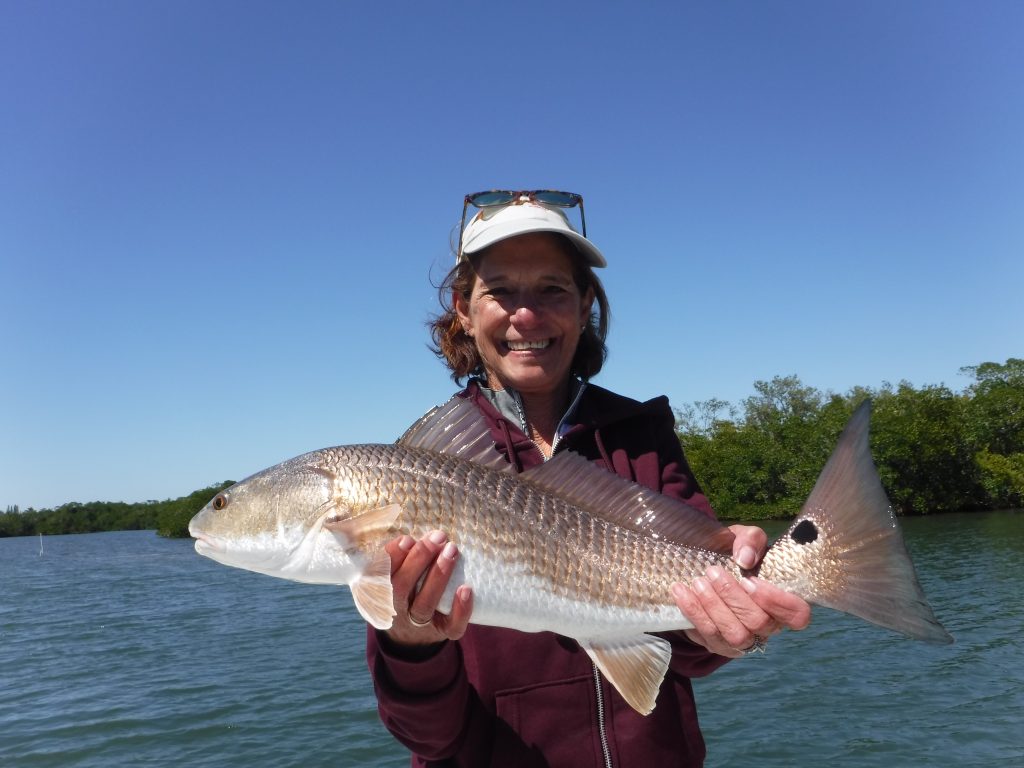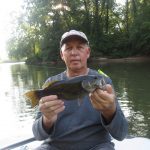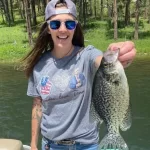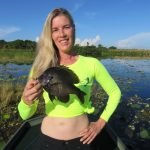Fishing for Redfish, a complete Guide
This comprehensive article will thoroughly cover how to catch redfish. Redfish are a very popular inshore saltwater game fish. They vary in size from a foot long to over 90 pounds.
Redfish, also known as red drum, puppy drum, and channel bass are found along the entire coast line from Texas to the mid Atlantic states. They inhabit the coastal waters and are found in tidal creeks, shallow flats, inlets and passes, and out on the surf. They are one of the most distinguishable species due to the big black spot on their tail.
Redfish have an inferior mouth, similar to black drum. This means that the nose of the fish protrudes out in front of the mouth. This gives anglers a clue as to its feeding habits. Redfish are built to route along the bottom for crustaceans and other forage. Their hard, pointy nose aids in this endeavor. However, redfish are opportunistic feeders and most certainly feed on bait fish heavily as well.
Fishing for redfish
Like all fish species, it is important to understand the habits and seasonal migrations of redfish in order to be successful. Juvenile redfish spend most of their time in bays, tidal creeks, and backwater areas. Shrimp and other crustaceans make up the majority of their diet in these early years.
Redfish reach maturity at around 4 to 5 years of age. They will school up in large numbers and move out of the bays and out into the nearshore waters of the Atlantic Ocean and Gulf of Mexico to spawn. This occurs in late summer and early fall throughout their range. Upon completion of spawning, most redfish will move back into the inshore bays. However, some will remain in the open waters as well.
Best redfish fishing tackle
While redfish can grow very large, the vast majority of redfish caught by anglers way between two and 10 pounds. The same inshore tackle that is used for speckled trout, school striped bass and bluefish, and flounder will work fine when fishing for redfish in most situations. Both spinning and bait casting tackle does a great job, it is just a matter of angler preference.
A 7 foot spinning rod with a medium action and paired with a 3000 to 4000 series reel is an excellent all round combination. It will allow anglers to cast lighter lures where required as well is fishing heavier baits and handling a large redfish should one be hooked. The reel can be spooled up with 10 to 15 pound monofilament or braided line.
Click these links to shop Amazon for redfish spinning and baitcasting combos!
“Fishing Lido Key is a participant in the Amazon Associates Program, an affiliate advertising program designed to provide a means for sites to earn advertising fees by advertising and linking to Amazon. As an Amazon Associate I earn from qualifying purchases. ”
Bait casting, or conventional tackle is quite popular for anglers fishing for redfish as well. This is particularly true along the Gulf Coast where anglers encounter larger redfish in the inshore waters. It is an excellent choice when casting heavier lures or rigs. Again, a 7 foot medium action rod with a matching reel and 20 pound braided line works well.
Redfish habits and behavior
Redfish thrive in a wide variety of environments. This is one of the keys to their success as a species. Redfish are found in brackish waters, though they do prefer a bit more salinity than some other species. There are situations in Louisiana and other marsh environments where redfish and largemouth bass can actually be caught in the same locations.
Many anglers associate redfish with shallow water flats, and for good reason. Redfish are built to feed on crustaceans. Shallow flats that consist of a mix of sand, grass, and oyster bars are prime environments for this forage. Naturally, redfish will be attracted to it. Minnows, finger mullet, pin fish, glass minnows, anchovies, and other bait fish will also inhabit these areas.
Check out these redfish fishing tips
Man-made structure will attract redfish as well. Docks, bridges, piers, , seawalls, and rip-rap will all attract and hold redfish. This is especially true in passes and inlets were current flow will create natural ambush feeding stations. These structures provide a break from the current as well as cover that attracts forage. All of these factors combined to make this type of man-made structure a good place to catch redfish.
Redfish are prized by anglers who enjoy surf fishing as well. While redfish can be taken from the beach anywhere along its range, this technique is particularly effective in the mid Atlantic states from South Carolina to Delaware.
Also, schools of large mature redfish are often encountered in the open waters of the Gulf of Mexico, particularly from Texas to the Florida Panhandle. These fish can be found right in on the beach as well as several miles offshore. They often relate to underwater structure such as artificial reefs and natural ledges.
Fishing for redfish; techniques
There are several different situations where redfish will be found. Each of these require specific tactics and techniques in order to be successful. Therefore, each will be covered in separate sections. They include; fishing the shallow flats, fishing structure, and surf fishing.
Fishing for redfish on the shallow flats
Most of the redfish caught by anglers are probably done so on the shallow grass flats and backwater creeks throughout their range. As mentioned above, this is prime habitat for the way a redfish is built and the manner in which it feeds. However, fish that feed in less than a foot of water can often times be very spooky and difficult to catch. Also, understanding tides and how it affects fish movements and behavior are crucial to success.
Tides are probably the most important factor affecting redfish on the shallow flats. To complicate matters, tides vary greatly depending on the part of the country an angler is fishing. Along the Gulf Coast, the water only changes 2 to 3 feet at most. However, in North Florida and South Georgia, tides can be as much as 10 feet. Experience is the best teacher and learning how these tides affect redfish in each geographical area.
To further complicate matters, the height of the tides changes due to a variety of factors. Tidal flow is caused by the gravitational pull of the moon. As the moon phases change, so do these current strengths. The highest and lowest tides are on the full moon and new moon. Conversely, the tides are weaker with less movement on the quarter moons.
Strong winds will also have an effect on water flow and height. In most instances, a north or northeast wind will result in less water or a lower tide while a strong south wind or southwest wind will do the opposite and flood the bays. A very low tide with a strong northeast wind can result in their being very little water. On the other hand, the combination of a high tide and a strong southwest wind will have the opposite effect.
How tides affect redfish movements
Understanding how redfish move with different stages of the tide is very important in order to locate and catch them. On low tides, fish will stage in deeper areas. There simply is not enough water on the flats for them to get up and feed. Deeper holes and flats may hold a lot of redfish and one small area. This is true also of troughs and depressions. Often times, redfish stage near flats in water that is just slightly deeper.
As the tide begins to flood or rise, redfish will move up onto the flat with it. Many anglers believe this is the best time to catch redfish as they are hungry and active and just beginning to feed. As the maximum high tide approaches, the flats will be flooded with water and redfish will scatter out. While they are still feeding, they can be difficult to locate.
As the tide peaks and begins to ebb out, redfish will reverse their movements and start easing towards deeper water again. This can be a difficult time to catch them. The fish have been feeding for several hours and they do not want to get stranded on the flat with no water. Fish that are spooked during this time will usually vacate the flat and not return. As the water reaches low tide, the cycle repeats itself.
Fishing for redfish with artificial lures
Most anglers chasing redfish in shallow water do so using artificial lures. There are couple reasons for this. Lures allow anglers to cover a lot of water in search of fish. Also, several lures are particularly effective for fishing through grass in shallow water. These include weedless spoons, spinner baits, and soft plastic lures.
Click this link to shop Amazon for Johnson Silver Minnow spoons
Perhaps the most effective weedless spoon is the Johnson Silver Minnow. It began its life as a lure used to fish for largemouth bass near lily pads and other vegetation. Redfish anglers quickly learned that it works quite well on their species. The spoon casts a long way and emits both flash and vibration. It rides with the hook up and has a weed guard, making it fairly weedless.
Click this link to shop Amazon for Redfish Magic spinnerbaits
Spinnerbaits are another freshwater lure that work well for redfish. They also cast a long way and combine the flash and vibration of a spoon with the bulk and action action of a jig. The Strike King Redfish Magic spinnerbait is a prime example. They are an excellent search bait that allows anglers to cover a lot of water and are also quite weedless. Most spinner baits used for redfish have a grub body on the jig head as opposed to a rubber skirt which is most often used in freshwater fishing.
Click this link to shop Amazon for Bass Assassin baits
Soft plastic baits are extremely effective on the shallow grass flats as well. They are a better choice when thoroughly covering an area once fish are located as the bait is worked much more slowly than spoons or spinnerbaits. The selections are endless and each geographical area has baits and color patterns that are productive. Local bait shops and tackle stores are excellent sources of information. These baits can be rigged it weedless on swim bait hooks or fished on an open hook with a jig head.
Click these links to shop Amazon for Cajun Thunder corks
Another popular technique that works very well for anglers fishing for redfish is to use a noisy float in conjunction with a soft plastic lure. These floats, called popping corks by some, are large noisy floats that have a concave top or have rattles. A leader between 18 inches and 36 inches long connects the float with a jig and grub. Some anglers use a plastic shrimp. Live shrimp is used under the same floats quite effectively as well.
Read more about the best redfish lures
When twitched sharply, the float puts out a loud popping sound which simulates feeding game fish and attracts redfish to the rig. This “pop” also causes the jig to jerk up and then flutter down seductively. So basically, the float attracts the fish and then once it is drawn to the sound it sees the jig and eats it. This works extremely well stirred up water where redfish cannot see and the sound really aids in bringing them to the bait.
Fishing for redfish with live bait
While many anglers target redfish using lures, live bait is also extremely effective. The top live bait by far is a shrimp. Redfish, and every other saltwater game fish, happily devour shrimp whenever possible. Live shrimp are also easy to obtain and are available at just about every coastal bait shop. They are fairly easy to keep alive. Crabs are also used as bait in some locations.
Live bait fish will fool redfish as well. The type of bait fish used really depends on the area being fished and the forage that is available. Pinfish and grunts are very popular throughout much of their range. Croakers are the top spot and some areas. Finger mullet, sardines, pogies, and other bait fish are used as well. In some situations, especially surf fishing, the bait is used as fresh cut bait instead of presented live.
Check out these top redfish baits
Live bait can be presented in a couple different ways. Where applicable, free lining a live bait works very well. This is simply hooking the shrimp or bait fish on the hook with no other weight included. This allows the bait to move about in a very natural and lifelike manner. Anglers often fish live bait under a popping cork. This is a noisy float used to suspend the bait at a desired level. It also attracts redfish and gives a visual reference when a strike occurs.
Top areas to find redfish
Anglers can both site fish and blind fish when searching for redfish on the shallow flats. Often times one angler fishes from the bow while another pulls the boat from a platform at the stern. Anglers can cast to likely looking spots or wait until a fish is spotted. Top spots include oyster bars, potholes, cuts and the shoreline or bars, and expanses of grass flats.
Redfish will also drop off of the very shallow flats and roam about in water between 2 feet deep and 6 feet deep to feed. In these situations, sight fishing really is not an option. The best choice is to drift an area and blind cast with lures or live bait in search of fish. Diving birds are an excellent sign of fish activity as are bait fish that are seen on the surface. Some days it can just be a matter of moving around until the fish are located.
Structure holds redfish
Fishing for redfish around structure is very similar to structure fishing for other species. Live or cut bait is most often used, though anglers can certainly fish with artificial lures as well. Casting lures works well when fishing a row of docks or drifting along the edge of a seawall or jetty. A jig head with a soft plastic grub is the best lure for this situation.
Anglers fishing with live or cut bait generally do best by anchoring up tide of the structure that is being fished. This allows anglers to present their bait back with the tide in a very natural manner. When fishing in passes and inlets, heavyweight can often be required. Anglers will constantly need to adjust the weight based on the tidal flow. This is particularly true on the East Coast inlets where current is quite strong. In many cases, the best time to fish these areas is during the periods of less water movement when the tide is changing.
Ledges are an example of natural structure that will definitely attract and hold redfish. These often occur in inlets and passes as well as other channels. Anchoring right on the edge of the ledge or drop off in presenting the bait can be extremely effective. Anglers in North Florida and Georgia catch some very large redfish using this technique. Cut bait such as crab or cut mullet is often used.
Surf fishing for redfish
Surf fishing for redfish is very popular all throughout the range. Along the Gulf Coast, the same techniques that work on the flats generally produce redfish off of the beach since the waves and surf are much smaller than in the Atlantic Ocean. A jig with a soft plastic grub body is an excellent choice, as are spoons. A live shrimp fished under a float or free lined will produce redfish as well. When the surf is a bit rougher, bottom fishing with a chunk of fresh cut bait is the best option.
Surf fishing for redfish really becomes popular in the mid Atlantic states, with the Outer Banks in North Carolina being “surf fishing central”. These anglers are serious about their surf fishing and have special rods and reels and other gear, including specialized vehicles for running out on the sand. Due to the rough surf and churned up water, most anglers opt for cut bait in this application. However, redfish can certainly be caught by anglers casting artificial lures when conditions are right.
Tides are important when anglers are surf fishing for redfish as well. High tide is generally preferred as it will often move fish into the first trough, closest to shore. On lower tide stages, making extra long casts out beyond the bar can be important. Also, locating cuts in the bars will produce redfish as they will use these to navigate out to deeper water.
Top spots for catching redfish
There are several areas of the country that are particularly productive when it comes to fishing for redfish. Each of these spots will be outlined with a short description of the area.
Venice, Louisiana
There can be little doubt that Venice, Louisiana is the redfish capital of the world. Redfish are abundant here and they grow very large. This is mostly due to the incredible amount of forage including shrimp, mullet, and other forage that is a result of the Mississippi Delta system. Also, it is a large area with perfect habitat for redfish. A boat is required for this area and most anglers opt for a guide as it is easy to get lost in the myriad of channels and islands.
Southeast Texas
The southeast coast line of Texas offers anglers fantastic fishing for redfish as well. This is a more traditional area of barrier islands with shallow bays between the islands and the mainland. The best fishing starts at Port O’Connor and goes south to South Padre Island. Laguna Mondrian particularly is legendary for its redfish and speckled trout fishing. Baffin Bay and Corpus Christi Bay are also quite productive. Anglers use special shallow draft boats to get around these bays and often get out and wade once they get to the productive areas.
Anglers can also do well in this area without a boat. Bridges, docks, seawalls, and fishing piers can all be productive spots for redfish. This area also offers anglers a lot of access to park their vehicle and wade out in search of fish. Finally, surf fishing can be productive along the entire coast line as well.
Northeast Gulf of Mexico
The Northeast corner of the Gulf of Mexico in the Stein hatchet, Florida area offers anglers fine redfish action as well. This is a fairly undeveloped and laid-back area that anglers will find a nice change of pace from some other more hectic spots. There are miles and miles of shallow flats in the Gulf of Mexico as well as title creeks and rivers that produce redfish. A boat is required and it is a tricky area when it comes to navigation as the bottom can be quite rocky.
Tampa Bay and Charlotte Harbor, Florida
Tampa Bay and Charlotte Harbor on the West Coast of Florida also hold good numbers of redfish. However, unlike some other areas, these fish get a lot of pressure and are difficult to catch comparatively speaking. Charter boat captains and guides often use live bait to chum the redfish up in a mood to feed. They are getting more difficult to catch on artificial lures. There are many public boat ramps and anglers without boats can access redfish by wading and fishing from docks, piers, bridges, and in the surf.
Jacksonville, Florida
Northeast Florida and southern Georgia offer anglers some fantastic fishing for redfish. This area is very well-known for catching large redfish in the inlets while bottom fishing with crab and other cut bait. This requires fairly stout tackle and a good knowledge of tides. Average sized redfish are plentiful in the back bays and countless title creeks and rivers. This area sees extreme tides, sometimes as much is 10 feet. These tides will result in redfish locations changing constantly.
Charleston and Savannah
The sounds and many rivers and creeks in this area offer perfect habitat for redfish. This area of the country does not get as much attention as some other spots, but offers world-class fishing for redfish when conditions are right. Anglers with boats can explore the creeks and rivers much better and cast lures or shrimp in search of fish. However, there are plenty of spots open to the public that will produce as well.
Outer Banks, North Carolina
Anglers looking to go surf fishing for redfish had for one spot; the Outer Banks in North Carolina. This is a very unique spot that is actually the easternmost point of the United States. The barrier islands of North Carolina jut out into the Atlantic Ocean further than any other spots in the country. Experienced anglers use very long surf rods, known as Hatteras heavers, to toss their offerings a long distance and to keep the line up over the crashing waves. Specialized four-wheel-drive vehicles are used to chase the fish up and down the beach. This is a specialized form of fishing that takes patience and experience, but is very rewarding. The inshore bays offer excellent fishing for smaller redfish as well.
Chesapeake Bay
Chesapeake Bay has experienced an increase in redfish numbers over the last decade or so. Fish of all sizes from smaller puppy drum to the larger cows are caught throughout the Bay. Bottom fishing with heavy tackle and large cut baits in the main shipping channel edges produces the larger redfish. Average sized reds are found in the many title rivers and tributaries of Chesapeake Bay. Surf fishing is also productive at Assateague Island and Chincoteague Island.
In conclusion, this article on fishing for redfish will help anglers catch more of these inshore saltwater game fish!
